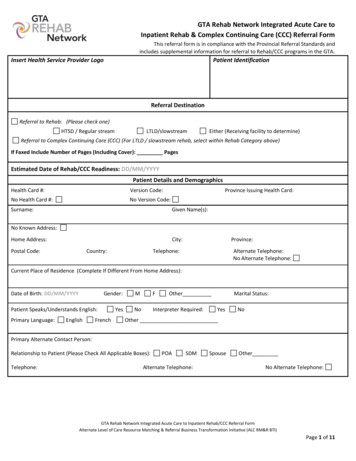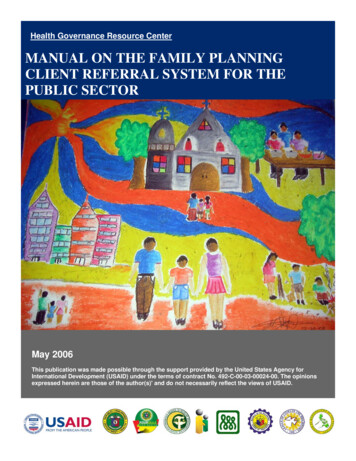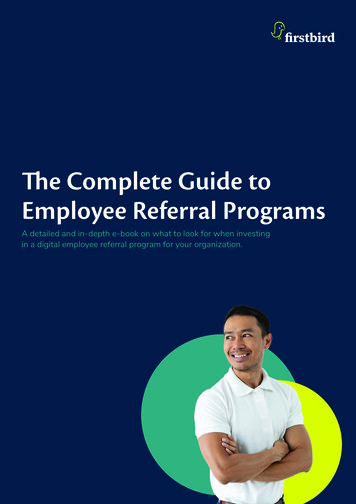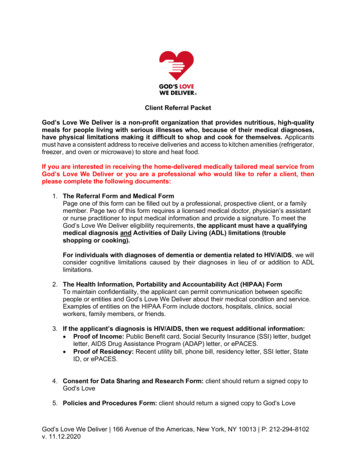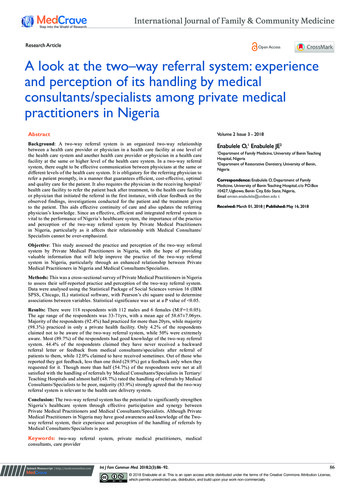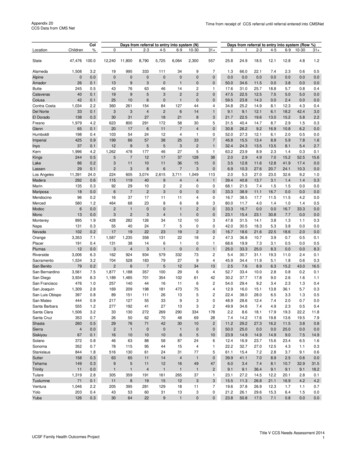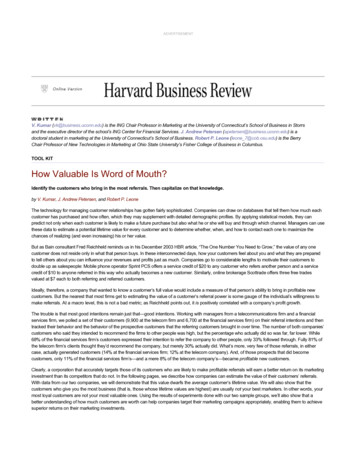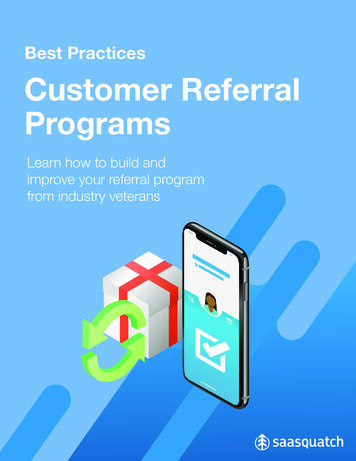
Transcription
Best PracticesCustomer ReferralProgramsLearn how to build andimprove your referral programfrom industry veterans
Table of ContentsIntroduction 3Chapter 1: What is Referral Marketing?Chapter 2: Effective user targeting46Chapter 3: Picking the right rewards10Chapter 4: User experience is everything15Chapter 5: Promotional tactics18Conclusion 24Page 2
IntroductionReferrals are key to growing any business, regardlessof size, industry, location, or market. While buyingpatterns have changed dramatically, what hasn’tchanged are the basic principles of human psychology:people are more likely to buy from people that theylike and trust.4xCUSTOMERS AREMORE LIKELY TO BUYWHEN REFERRED BYA FRIENDThe stats about referral marketing only validate this long-held belief:people are 4 times more likely to buy when referred by a friend, thelifetime value of referred customers is 16% higher, and 14% (yes14%!) of customers who visit a referral page take an action.But with all this knowledge about the value of referrals, only 30% ofcompanies have a formalized referral program, meaning the majorityof brands have a significant untapped growth opportunity sitting rightin front of them.16%APPROXIMATELYIn this eBook, we’ll layout the best practices for creating customerreferral programs that drive growth. The strategies and tactics weprovide are based on extensive real-world experience. We’ve workedwith organizations around the world - and across industries - to designand implement referral marketing programs that drive results.The process of designing an effective referral marketing program canbe broken down into 4 key areas: targeting, rewards, promotions, anduser experience.In the following pages, we’ll provide real-worldexamples and tactics that you can use to build yourown referral programs.HIGHER LIFETIME-VALUEFROM A REFERREDCUSTOMER30%ONLYOF COMPANIES HAVE AFORMALIZED REFERRALPROGRAMPage 3
Chapter 1What is ReferralMarketing?See how customer referralshelp you to stay ahead ofyour competition
What is Referral Marketing?Before we get into specific strategies and tactics, let’s make sure we’re all on the same page when it comes towhat referral marketing is. It’s likely we’ve all received referrals from friends and family, but it’s only been inrecent years that referral marketing has established itself as a formalized marketing channel.Referral marketing is often used as an umbrella term to describe a range of marketing strategies where customersare encouraged to share the word about a product or service. From refer-a-friend programs that incentivizecustomers to share offerings with their social circle, to affiliate programs that pay influencers to promote yourproduct or service, there are several types of programs that fit into this category.For the purpose of this eBook, everything we talk about will be in the context of customer referral programs.What’s Changed?We’ve been working closely in the referral space for more than 6 years and have seen a ton of change during thattime. Here’s a couple of the big things we’ve noticed.Consumer expectations are higherIt’s no secret that buyers are more informed than they ever havebeen, and there are more choices than ever before. With access toinformation always at the tip of our fingers, the power has shifted tobuyers at an unprecedented rate. The expectations of your customersand potential customers are only getting higher. Compounding thisaffect, the majority of buyers are most of the way through the buyingprocess before they explicitly interact with your company.Growth automationWhen we consider the rise in consumer expectations, it’s obvious thatmarketers need to reframe how they think about referral programs.We’re seeing an increased desire for more than just give/get referrals.Companies want tiered rewards, detailed analytics, and programs foraffiliates and partners.Referral marketing is no longer just about the top of the salesfunnel; it’s about full-funnel loyalty. Companies should be thinkingabout increasing revenue per customer from acquisition throughto retention - referral are just the tip of the iceberg. You need to bethinking loyalty at all stages of the customer journey.Page 5 - Chapter 1“Referral platforms offereverything we need torun a successful program.Implementation is quick andthey have been key in thegrowth of our business overthe past year.”Ben FriedmanHead of OperationsAll Set
Chapter 2Effective UserTargetingFive key areas you should bepaying attention to when targetingusers for your referral program
Effective User TargetingThere are several factors thatseparate successful referralprograms, but of those, effectivetargeting may be the mostimportant. In order to attract highquality prospects and leads, youneed to ensure that your referralprogram targeting is dialed-in andoffers are tailored to your targetprospects.Targeting ultimately defines howthe rest of your program will bedesigned. Companies that dotargeting right see higher returnson their programs. You want tomaintain positive sentiment ofyour company, so avoid targetingusers who are indifferent or have anegative perception of your brandor industry.The big question is, how do youeffectively target your referralprograms? Below are the key areasyou should be paying attention towhen developing targeting for yourreferral programs.Assess Your ReadinessReferral programs are only as goodas your customers’ willingnessto recommend your product orservice. Before kicking off anyreferral marketing activities, youneed to assess your company’sreadiness for a referral program.A good place to start is listeningto your customers and solicitingtheir feedback. This is somethingyou should always be doing, andis of particular importance whenexploring referrals as a marketingchannel. If you’re having difficultypleasing your customers andproviding a positive experience,you can’t expect much in terms ofrecommendations from them.The NPS (net promoter score)method of collecting customerfeedback is an excellent place tostart. It’s easy to implement, anddoesn’t require much effort on thepart of your customers. It asks thequestion of how willing would acustomer be to recommend yourproduct or service based on theirinteraction with your company, withusers selecting a number from 1-10.The automatic scoring programthen provides you with an overallPage 7 - Chapter 2score of your customers’ willingnessto recommend, with respondentsbeing placed in one of three groupsbased on their score. Promoters(score 9-10) are loyal enthusiastswho will keep buying and referringothers. Passives (score 7-8) aresatisfied, yet unenthusiasticcustomers who are vulnerable tocompetitors. Detractors (score 0-6)are unhappy customers who candamage your brand and impedegrowth through negative word-ofmouth.By subtracting the Detractors fromthe percentage of Promoters, youreceive the NPS, which rangesfrom -100 (if every customer is aDetractor) to a high of 100 (if everycustomer is a Promoter).If your NPS is low, we recommendidentifying ways to improve itbefore getting started referrals. Ifyou have a strong NPS, referrals area great way to grow your businessand increase customer lifetimevalue. It’s important to compareyour NPS score with others in yourindustry as “good” can be verydifferent depending on the marketyou’re in.
Identify the Right ReferrersIdentify the Right RefereesOnce you’ve determined your organization’s readinessfor referral marketing, it’s time to break it down furtherto identify your best referrers — the people that aremost likely to make recommendations.For many of the same reasons you need to choose theright referrers, you need to ensure that your targetreferees (the ones being referred by your existingcustomers) are the right fit for your program.It may seem obvious, but start by identifying yourhappiest customers as they’re the most likely to referyour product or service to their friends and family. Youmay even consider tiering the rewards you offer to thereferrers.The offer needs to resonate with the target audience,or they’ll just see it as noise and your conversion rateswill suffer. There are many characteristics to considerfor your target referees, and they vary depending on thetype of program you’re designing.Your subset of the happiest customers may deservea larger incentive. You just want to be sure that anyincentives you offer are profitable for your company —don’t offer more than you can afford to pay to acquirenew customers based on lifetime value.Personas that you’ve designed for other marketingprograms can be applied to your referral programs, too.These details about your market are extremely valuableand will help you determine which audiences your offeris most likely to resonate with.Another consideration when choosing the rightreferrers is their level of engagement. You may verywell have happy customers that are not that engaged.A sweet spot for referrers is those that are happy withthe service they’re receiving, and engaged with yourbrand.Today, engagement is primarily measured online, so wesuggest reviewing your company’s emails, social mediaaccounts, online communities/support centres, andanywhere else you engage with your customers thatyou can measure.Page 8 - Chapter 2
Reach your Customers Where They AreA significant piece of effectively targeting your referral program is understanding your target audiences’online behaviour and characteristics. Most people belong to many different platforms that your brandscan engage with them on, and everyone uses each platform a little bit different.You also need to understand how different channels are used throughout the buying process. Forexample, most organizations are able to generate significant amounts of engagement and trafficthrough Facebook shares, but their conversions tend to be driven by email and direct link copies.You need to reach your customers and potentialcustomers everywhere they are, as well as with theright message for that particular platform.A consistent experience across all channels, combinedwith relevant messaging for the particular channelor stage of the buying process will help drive moreconversions for your organization.Get Granular with Your TargetingWe hear about the importance of personalization fromeverywhere, and today, personalization is easier than ever. For too many, however, this still means simply pullingdynamic fields into emails (e.g. Hi first name ).When we talk about personalization, we mean getting granular with your referral program targeting.It’s about understanding your customers and business. If you offer ride sharing, you may know that certain eventsor festivals are a great time to offer referrals. You’re more likely to reach people that need transportation, sooffering a targeted ride discount referral is likely toresult in higher conversions.It goes back to having an intimate understanding of howyou generate business and the characteristics of yourusers. Getting granular with targeting will allow you todrive higher conversion rates and provide a stronger,more tailored experience.Take the ride share example: if a successful referrer alsogets 10 off a ride, it makes their night out that muchbetter.Page 9 - Chapter 2
Chapter 3Picking the RightRewardsGood, relevant rewards makereferral programs successful
The Right Rewards for Your CustomerThe importance of choosing the right reward can be summarized in onesentence — valuable relevant rewards get referrals. So it’s no surprisethat poor reward selection will make your referral programs a waste oftime and money.The key to making the right choice is understanding the intrinsicmotivations of your referrers. This will allow you to match the rewardsof your program with the needs and desires of your customers, makingthe program more meaningful for users and more profitable for you.The single-sided rewardstructure is used bycompanies like GoogleApps, Hulu, and Grouponto incentivize userreferrals.The best way determine what motivates your customers and potentialcustomers is to find a way to talk to them. There are many forums forseeking customer feedback: focus groups with existing customers, onlinesurveys distributed to customers and lookalike audiences, social mediapolls, and calling campaigns are all effective ways to gather the feedbackyou desire.The motivations of your customers and potentials customers that youuncover will help you determine the best types of rewards you offer.Single-sided vs double-sided rewardsSingle-sided rewards mean only the sender of the referral receives areward for referring a new customer. Single-sided rewards are typicallymuch easier to manage and deals mainly in cash or credit.While single-sided rewards do have their place, there can be challengeswith single-sided rewards. It can be interpreted as a lack of balance andcan cause people to be weary of whether the referrers intentions arepure, or if they’re just after a reward.Double-sided rewards incentivize both parties of the referral. Uponsuccessful referral conversion, both referrer and referee get a reward.Double-sided rewards appeal to a wider group of users and canstrengthen your reputation at the same time. This is attributed to bothparties feeling that they are on equal footing as they both stand tobenefit from the referral.Page 11 - Chapter 3There are many companiesfueling significant growthusing double-sided rewardprograms, includingDropbox, Airbnb, Typeformand Pluralsight.
Find What Works for YouFixed vs. Variable RewardsFixed rewards are when there is a set incentive for both sides of a referral. Variable rewards let people choosefrom a menu of items or receive more value with more successful referrals.In our experience fixed rewards are much more cost-effective and simpler to manage from an operationalperspective. Fixed rewards are quick and easy to implement and track, and you don’t have to worry about toomany competing incentives among your target audience.While variable awards can provide more options to your audience, they add a level of complexity to yourprograms that can have a negative effect on conversions.To pick what’s best for your organization, you need to consider the size of your industry and market, as well asthe operational capacity of your marketing and sales teams. You want to avoid adding needless convolution toyour referral programs.Cash vs. Credit RewardsCompanies in the subscription, SaaS andon-demand space have seen success inoffering non-cash rewards like accountupgrades, pro feature access, and freecredit.Not only can cash rewards cost you more,be more difficult to manage and reduceconsumer-to-consumer referrals, theyalso don’t guarantee more engagementwith your product or service.If users get access to account upgradesor a new feature set, you’re only going tohelp them derive more value.Consider Dropbox, SpiderOak, and SugarSync: each has experiencedmassive success by offering free storage (not cash) to both parties.Page 12 - Chapter 3
Find Your CurrencyIf we look at ride-sharing companies such as Uber, 99, and Lyft, they have referral programs that offer creditincentives. Similarly, streaming media companies like Netflix offers free subscriptions for a month at a time.The takeaway? Your product or service offering will determine if cash make a better reward.As a general rule, rewarding participants with your “business currency”, whether discounts, features or credits,is a good idea.4 Tips to Help you Choose the Right Reward1. Listen to your usersYou should always be listening to your customers,across all functions of your business. Differentsegments of your customers have different needsand motivations that will determine the best wayto service them, and to engage with them forreferral programs.For example, paid users will have differentmotivations than free users. Free users may bemotivated more by non-credit rewards becausethey’re aren’t paying for your service, butupgrades or new features may motivate them tomake a referral.2. Keep things seamlessConsumer patience is continually diminishing -successful referral programs need to be seamless forboth the referrer and referee.Your rewards need to be easily understood by yourtarget audience. It’s extremely easy to lose theinterest of your audience if your rewards or rewardstructure is too complex.Furthermore, if there are too many steps requiredto successfully complete a referral and receive thereward, people will simply avoid your program. Youneed to make it as simple as possible to send andreceive referrals. Don’t make people jump throughhoops to send links to their friends and family or theywon’t do it. The more seamless it is, the more likelyyour customers will be to share.You also need to provide visibility throughout theentire process. Similar to ambiguous details, a lack ofvisibility can make for a poor experience. You wantto ensure that both referrers and referees alwaysunderstand where they’re at in the process.Page 13 - Chapter 3
Be Sure to Provide Value24%NON-CASH INCENTIVES AREMORE EFFECTIVE THANCASH INCENTIVES3. Be creativeBeing creative with the incentives you offer can notonly improve conversions and LTV, it can make for aunique customer experience. While discounts andcredits may be great for most cases, they don’t workfor every scenario. It may come as a surprise, butnon-cash incentives are 24% more effective.4. Don’t be too thriftyOf course you need to pay close attention to yourbudget to ensure your programs are profitable, butdon’t be too thrifty with your rewards. Choosingsmall rewards will help keep costs down, but theydon’t provide a ton of value. The likely result is a lackof participation, engagement, and revenue growth.Think about ancillary products that your customersmight be interested in. If you were exploring how toget referrals for on online tutoring platform, suchas Varsity Tutors, you might want to think aboutincentives that would benefit students outside of theplatform. Perhaps it’s in the form of a credit for bookson Amazon, or an incentive for the parents if you’redealing with students outside post secondary.This is where you really want to know your customeracquisition cost and lifetime value. Make sure youunderstand what you can afford to pay to acquirecustomers, how much you pay on other channels,and the lifetime value of the different groups you’retargeting.A great example of where you need to get creativewith incentives is in the B2B space. While you mightbe selling to businesses, you’re ultimately dealingwith a person. And a discount on a product theircompany purchases is not likely to excite them. This iswhy in a B2B situation, digital gift card rewards are agreat option.Page 14 - Chapter 3While you don’t need to break the bank foreach referral, you need to offer something thatis incentive enough for someone to put theirreputation on the line and refer your product orservice.
Chapter 4User Experienceis EverythingFive ways to deliver an amazingcustomer exerperience
Consistency and SimplicityToday’s businesses need to create a killer customer experience for every leg of the customer journey. Sincepeople are more likely to share negative experiences than they are good ones, UX becomes even moreimportant when asking for referrals. You can’t just rely on a good customer experience, you need to deliveran amazing experience. This is particularly true when most of your business is done without interacting withcustomers in-person.Poor user experience is one of the top causes of failure in referral programs. Here are 5 best practices when itcomes to designing the user experience of your programs.1. Deliver a consistent experienceDelivering a consistent experience is about the lookand feel of your programs, as well as the customer’sinteractions throughout the process.Nothing is more frustrating than being misinformedabout what’s required to send a referral and receiveyour incentive. Be sure that it’s obvious what peopleneed to do to take advantage of the offer, and don’thide important details in fine print. The last thing youwant to do is create a poor experience at the point acustomer is about to refer your product or service toa friend.The look and feel of your referral program should alsomatch your company’s brand standards — peopleshould know exactly who it is they’re interacting withno matter which platform they’re on.The same way that referrals rely on the trust betweenthose making and receiving the referral, your referralprogram relies on the trust that your customers havein your brand. Capitalize on the relationships you havealready established with your customers.Page 16 - Chapter 42. Keep things simpleA clear design and message can go a long way toimprove a referral program’s performance. The easierit is to understand and the less hoops your customershave to jump through to receive their reward thebetter! Before launching a program ask ‘Could I explainthis in one breath?’People not only expect a seamless experience, theydemand it. Your programs need to be simple and easilyunderstood. Do everything you can to remove frictionand any unnecessary complexities.Keeping things simple not only provides a betterexperience for your potential customers to grasp, itremoves operation challenges that come with overlycomplex programs.
Continuous Improvement3. Plan for a range of channels4. Continually make enhancementsWhether it’s email, mobile, desktop, or social, youwant to ensure that your program delivers a consistentexperience across each channel you interact withcustomers on. Limiting your program to one or twomediums means limiting your program’s potential forsuccess.Things move fast in today’s business world, andyou need to be able to adapt to the changingenvironment. It’s critical that you are constantlylooking for ways to improve your programs and yourcustomers’ experiences with them.Gone are the days of either reaching people via phone oremail. Most people spend their time online across a rangeof social and digital channels, and you need to be sureyou’re prepared to reach them everywhere they are.A new and exciting channel that has emerged in recentyears are online messaging platforms such as Slack,Messenger, and WhatsApp. These new means of reachingcustomers present great opportunities to engage withpotential customers in new ways, including using AIbased tools to book meetings and respond to questionseven when you’re not online.Having multiple touch points for your referral offer willhelp increase the usability and performance of yourprogram. Offering a variety of share buttons within yourprogram will help ensure that your customers can easilyand effectively make referrals using the medium(s) thatbest suit them and their social circles.Page 17 - Chapter 4Make sure that you’re periodically testing theusability of each element of your program.Reviewing the user experience from both sides ofthe funnel (referral homepage, copy, CTA button,referral landing page, reward amount/type, websitenavigation etc.) can provide valuable insights intowhat areas have room for improvement. Implementthe changes, analyze performance, and test again.5. Ask for FeedbackYour customers are your most valuable resourcefor understanding how your program is performing.Almost all things you do should be rooted incustomer demand, and your referral programs andother marketing tactics are no exception.You should always be designing your programs foryour users, so we recommend formalizing a programfor seeking feedback. It does not need to be overlycomplex - it’s important to keep your asks shortand direct - you do not want to overwhelm yourcustomers.
Chapter 5PromotionalTacticsThe keys to successful referralprogram promotion
Designing & PromotingThe Keys to Successful Referral Program PromotionThere’s should be no debating the importance of an effective promotion strategy. Regardless of how strong youroffer or how innovative your product, if people don’t know about it they’re not going to buy it. Here are five stepsto properly promoting your referral programs.Step 1: Include a compelling call-to-action (CTA)This one may seem obvious, but too often we see brands make their CTAs toodifficult to find, or fail to include one. If you want to drive conversions, youmust provide an easy mechanism for people to take the action you want.Your referral program CTAs should be clear, compelling, andnot competing with other calls-to-action. There might be aninclination to include different options or hide your referralprogram deep in a menu, but these cause serious negativeimpact on someone’s tendency to take action.Here are a few tips forcreating compelling CTAs:Good Design is Worth the InvestmentYour CTAs need to be noticable, and people aredrawn to good design. Think about using colors,images, or even in-app “ad units” to communicateyour message. Be thoughtful about your designand be sure to test different iterations.Be ConciseDetailed content containing benefits and sharingexamples should be reserved for marketing copy.CTAs need to be clear and concise — the sooneryou get to the point, the faster your customers cantake the next step. People have ever diminishingattention spans, so grab their attention quick.Page 19 - Chapter 5Mind your LanguageLanguage, similar to design, brings out different emotionsin people and drives different behaviour. Choosing theright words for your CTA can work wonders. Opt formore meaningful and warmer terms such as “invite”, “tell afriend”, “send invitation”, etc. Uber uses “share Uber” andWorld of Warcraft uses “recruit a friend”.Test, Test, TestIt’s conversion rate optimization 101 — you should alwaysbe testing your CTAs. Promotion decisions should be madebased on data. We recommend A/B testing with differentplacement, color, and messaging to see what resonates anddrives higher conversion rates.
Grab the Attention of Your CustomerStep 2: Integrate CTAs into all your marketingchannels.Yes, you read that right – all marketing channels.People’s online habits vary significantly from channelto channel.EmailEmail presents a great opportunity for CTAintegration. We recommend including a footer CTAin system notifications, monthly newsletters, reports,activity digests, and other emails. Email can alsobe leveraged at other stages of your customer lifecycle, such as purchase confirmation, onboarding orsubscription renewal messages, which are all placesthat you should include your referral program CTA.Social mediaSocial has become one of the most powerful channelsto use when engaging with your current and futurecustomers online. By thoughtfully integrating yourCTAs into the right social platforms you not onlyfoster a stronger more personal relationship withyour customers but you also allow them to helpbuild your brand’s reputation amongst their socialnetworks.Take for example Teach Starter - they made it easyfor their subscribers to share their referral codesover social by generating unique images for eachuser and promoting the referral program heavily forone month. This campaign resulted in 1500% morereferrals for the month of their promotion.Page 20 - Chapter 5“Social is one of thebest places to interactwith customers andpotential customersonline.”Landing PagesLanding pages are a valuable tool when it comes torunning referral programs. If you’re running a programthat is primarily online (or even if you’re not), you shouldbe driving traffic to a targeted landing page that drivesleads, appointments, or sales. Landing pages can befocused on driving one behaviour, and are easy to iterateon and test to determine what combination of content,design, and CTA drives the most conversions.Indochino is a great example of how landing pages canhelp drive conversions for your organization. Indochinoprovides customized landing pages based on wherethe searcher is located, allowing them to tailor theirmessaging and CTAs based on benchmark data in aparticular market.
Attention is ShiftingMobileMost people spend more time on mobile devices than they docomputers, which opens up a few different ways to reach peoplewith referral offers. Mobile applications (for those businessesthat have them) present an opportunity to reach your users whenthey’re actively engaged with your brand. You can also reach peoplevia SMS, Whatsapp and Facebook Messenger which are a few ofthe most personalized sharing mediums available.Many organizations are leveraging Facebook Messenger to connectwith users on their mobile devices, and it is opening up new andinteresting ways to engage with potential customers. A greatexample of this comes from Sephora: Sephora used Messengeras a location to drive paid traffic instead of a typical landing page.This way they were able to engage the customer in a conversationimmediately, rather than relying on them to submit a form on alanding page.The right approach ultimately depends the channels you interactwith your customers on. Understanding this in detail will help youprovide a better customer experience across online and offlinechannels, and the channels they are most likely to convert on.Step 3: Create original content for your referral programCreating valuable content is a key part of any marketing strategy,and a great way to improve the success of your referral programs.Blog posts and FAQs are the most common channel of originalcontent production for companies, with video and audio growing ata rapid pace.If you want to create original content related to referral programs,try to generate topics that provide value to your existing andpotential customers — as with social, it can’t only be aboutpromoting your offer. Find something that relates to your programin a broader context, something that resonates with people. Makeyour program topical with what your target audience is thinking ortalking about.Page 21 - Chapter 5“Referral marketingis one of our mostsuccessful customeracquisitionchannelsto date.”Stefan TouzierCEO & FounderEq
and implement referral marketing programs that drive results. The process of designing an effective referral marketing program can be broken down into 4 key areas: targeting, rewards, promotions, and user experience. In the following pages, we'll provide real-world examples and tactics that you can use to build your own referral programs.
